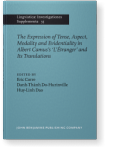Chapter 9
Imperfectivity in L’Étranger in French, English, Breton
Eric Corre | University Sorbonne Nouvelle – Paris 3
Cross-linguistically, progressive constructions,
a sub-category of imperfectives, often have a locative origin, but
they take on a host of language-specific meanings. This corpus-based
study focuses on the narrative and descriptive modes in English and
Breton translations of the novel: in both languages, the progressive is analyzed as a
stativizing operator (De Swart,
1998; Michaelis,
2004, 2016),
which gives rise to backgrounding and subjective uses. However whereas
English has a general purpose simple past alongside the progressive,
Breton has an imperfect and a progressive. The
purpose of the paper is to provide a fine-grained analysis of the
similarities and differences of a superficially similar form, taking
into account the competing tense-aspect possibilities offered by two
unrelated languages.
Article outline
- 1.Introduction
- 2.Presentation of the method and definitions
- 2.1Method
- 2.2Definitions: Imperfective, Progressive
- 2.2.1Common definitions
- 2.2.2The Breton prog
- 3.Frequencies and cross-linguistic differences
- 3.1Multilingual perspective
- 3.2Monolingual perspective
- 3.2.1English: Variations in the use of progs
- 3.2.2Breton: A “fake” progressive construction
- 4.Comparative analysis of the English and the Breton progressives
- 4.1The English prog and its Breton translations
- 4.2The Breton prog and its English translations
- Conclusion
-
Notes
-
References
References (36)
References
Adamczewski, H. (1978). BE+ING
dans la Grammaire de l’Anglais
Contemporain. Paris: Editions Champion.
Adamczewski, H. (1982). Grammaire
linguistique de
l’anglais. Paris: Armand Colin.
Asher, N., & Lascarides, A. (2003). Logics
of
Conversation. Cambridge: Cambridge University Press.
Bertinetto, P. M. (2000). The
progressive in Romance, as compared with
English. In Ö. Dahl (Ed.), Tense
and Aspect in the Languages of
Europe (pp. 559–604). Berlin/New York: Mouton de Gruyter.
Bottineau, D. (2010). Les
temps du verbe breton : Temps, aspect, modalité,
interlocution, cognition – des faits empiriques aux
orientations
théoriques. In C. Douay (Ed.), Système
et
chronologie (pp. 129–157). Rennes: Presses Universitaires de Rennes.
Boulonnais, D. (2018). BE
+ -ING in Old and Middle English: from durative to
imperfective to
progressive. Unpublished
Manuscript.
Bybee, J., Perkins, R., & Pagliuca, W. (1994). The
Evolution of Grammar : Tense, Aspect, and Modality in the
Languages of the
World. Chicago: University of Chicago Press.
Camus, A. (1942). L’Étranger (Gallimard,
Collection Folio); The
Outsider (Penguin Books, 2012; translator: Sandra Smith); The
Outsider (Everyman’s Library, 1982; translator: Joseph Laredo); An
estren (Skrid, 2016; translator: Erwan Hupel).
Comrie, B. (1976). Aspect:
An Introduction to the Study of Verbal Aspect and Related
Problems. Cambridge: Cambridge University Press.
Corre, E. (2005). L’auxiliarité
en anglais et en breton. Le cas de do et
d’ober. Cercles,
Occasional Papers Series, Revue pluridisciplinaire du monde
anglophone, [URL], 27–52.
Croft, W. (2012). Verbs:
Aspect and Causal
Structure. Oxford: Oxford University Press. 

Dahl, Ö., & Wälchli, B. (2016). Perfects
and iamitives: two gram types in one grammatical
space. Letras de
Hoje, 51(3). 325–348. 

De Swart, H. (1998). Aspect
Shift and Coercion. Natural
Language and Linguistic
Theory, 16. 347–385. 

De Swart, H. (2000). Tense,
aspect and coercion in a cross-linguistic
perspective. Proceedings of
the Berkeley Formal Grammar
conference, 20. Berkeley: University of California, CSLI Publications.
De Wit, A., & Brisard, F. (2014). A
Cognitive Grammar Account of the Semantics of the English
Present Progressive. Journal
of
Linguistics, 50(1), 49–90. 

De Wit, A. (2017). The
Present Perfective Paradox Across
Languages. Oxford: Oxford University Press.
Donabedian, A. (2012). Evidentiel
et progressif : quel statut grammatical pour la saillance
prédicative ?. Saillance,
Faits de
Langues, 39, 65–82. 

Franckel, J.-J. (1989). Étude
de quelques marqueurs aspectuels du
français. Genève: Droz.
Furkó, P. (2014). Perspectives
on the translation of discourse
markers. Acta Universitatis
Sapientiae,
Philologica, 6, 2, 181–196. 

Gosselin, L., Mathet, Y., Enjalbert, P., & Becher, G. (2013). Aspects
de l’itération. L’expression de la répétition en français :
analyse linguistique et
formalisation. Berne: Peter Lang.
Guillemin-Flescher, J. (2003). Théoriser
la traduction. Revue
française de linguistique
appliquée, 8(2), 7–18. 

Hewitt, S. (1990b). Auxiliary
in
Breton. In J. L. Duchet (Ed.), L’Auxiliaire
en question, Travaux linguistiques du
CERLICO (pp. 57–66). Rennes: Presses Universitaires de Rennes.
Jespersen, O. (1924). The
Philosophy of
Grammar. London: G. Allen and Unwin.
Larreya, P. (1999). BE
+ -ING est-il un marqueur
d’aspect ? Anglophonia,
French Journal of English
Linguistics, 03 (6), 135–150.
Lebas-Fraczak, L. (2010). La
forme être en train de comme éclairage de
la fonction de
l’imparfait. Cahiers
Chronos, vol.21. 161–179.
Michaelis, L. A. (2004). Type
Shifting in Construction Grammar: an Integrated Approach to
Aspectual Coercion. Cognitive
Linguistics 15, 1–67. 

Michaelis, Laura A. (2016). “Serving
a Slice of Time: Unifying Tense, Aspect and Modality with
Aspectual
Constructions“. Paper
presented at the Conference
‘Tense, Aspect, Modality, Evidentiality:
Comparative, Cognitive, Theoretical, Applied
Perspectives’, Paris, November
2016.
Ó Corráin, A. (1997). On
Verbal Aspect in Irish with particular reference to the
Progressive. In S. M. Mathúna & A. Ó Corráin (Eds.), Miscellanea
Celtica in Memoriam Heinrich Wagner. Acta Universitatis
Upsaliensis. Studia Celtica Upsaliensia
2. Stockholm: Almqvist and Wiksell. 159–173.
Rouveret, A. (1994). Syntaxe
du gallois, Principes généraux et
typologie. Paris: CNRS éditions.
Smith, C. (1991). The
Parameter of Aspect. The Netherlands: Kluwer Academic Publishers. 

Smith, S. 2012. The Outsider. Penguin Modern Classics.
Vafaeian, G. (2018). Progressives
in use and contact. A descriptive, areal and typological
study with special focus on selected Iranian
languages. PhD
dissertation, Stockholm University, Department of Linguistics.
Vendler, Z. (1957). Verbs
and
Times. In Linguistics
in
Philosophy [1967]. Ithaca, New York: Cornell University Press, 97–121.
Zanettin, F. (2014). Corpora
in
translation. In J. House (Ed.), Translation:
A Multidisciplinary
Approach (pp. 178–199). New York: Palgrave Macmillan. 

Cited by (1)
Cited by one other publication
Maroiu, Amelia-Diana
2022.
Review of Temporality in Romanian Editions of The Stranger by Albert Camus.
Transilvania ► pp. 46 ff.

This list is based on CrossRef data as of 30 july 2024. Please note that it may not be complete. Sources presented here have been supplied by the respective publishers.
Any errors therein should be reported to them.
